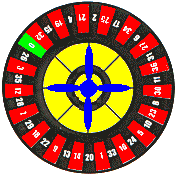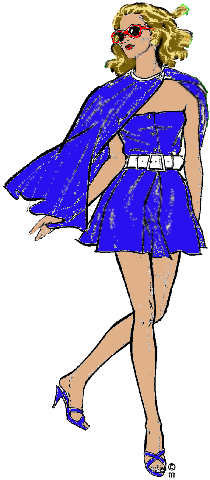[Adrian] I have never gambled, not on a horse, a dog, a card game or bought a lottery ticket. I think I have 5p profit on three goes in fruit machines! But when I was younger I had a Roulette game, which, on the same day as a Radio 4 programme on the subject with Adam Hart-Davis in January 2002, I found in a charity shop in good condition for £1. So I bought it. Nostalgia!
| Kind of Play | Odds multiplied by the Stake | The Chips are placed on following positions |
| On any single number, 0-36 | 35 to 1 | On the number |
| On any pair of adlacent numbers, i.e. 2 and 3, or 13 and 16 | 17 to 1 | On the line separating the selected numbers |
| On any three horizontal numbers, i.e. 16, 17 and 18 | 11 to 1 | On the line at the side of the 3 numbers, left or right |
| On 4 numbers in a square, i.e. 26, 27, 29 and 30 | 8 to 1 | On the point of intersection of the 4 numbers |
| On two adjacent rows of three, i.e. 1, 2, 3 and 4, 5, 6 | 5 to 1 | On the right or left line at the point of intersection of 2 numbers and the side line |
| On the first 12 numbers. i.e. 12P or P12 (1-12) | 2 to 1 | In square 12P or P12 |
| On the middle 12 numbers, i.e. 12M or M12 (13-24) | 2 to 1 | In square 12M or M12 |
| On the last 12 numbers, i.e. 12D or D12 (25-36) | 2 to 1 | In square 12D or D12 |
| On a vertical column of 12 numbers (1-34, 2-35, 3-36) | 2 to 1 | In the square provided at the base of the column |
| Pair (even numbers) | Evens | In the section marked PAIR |
| Impair (odd numbers) | Evens | In the section marked IMPAIR |
| Rouge (Red numbers) | Evens | In the Red diamond section |
| Noir (Black numbers) | Evens | In the Black diamond section |
| Manque (1-18) | Evens | In the section marked NOIR |
| Passe (19-36) | Evens | In the section marked PASSE |

The person in charge of the wheel is called the Croupier. He or she also operates the rake.
The Croupier takes all stakes when zero turns up except the one on '0' itself, and Zero is paid out like all numbers at 35-1.
The rake is used by the Croupier for drawing in the losing counter's and pushing the winnings to the winners.
The Croupier starts the game by calling “Make your Play”. When the stakes are all down the Croupier says “No More Bets”, spins the wheel clockwise and sets the ball going anticlockwise.

This roulette wheel so operated is basically a random number generator. The numbers on the European wheel are 0, 32, 15, 19, 4, 21, 2, 25, 17, 34, 6, 27, 13, 36, 11, 30, 8, 23, 10, 5, 24, 16, 33, 1, 20, 14, 31, 9, 22, 18, 29, 7, 28, 12, 35, 3, 26, which add up to 666.
Casinos usually ban people who go in with computers (on the body, in clothing, or otherwise) who may try to enter data on the habits of the wheel and Croupier, to try to calculate which is a more probable area for the ball to fall given its starting position. This is still subject to many random variations and the casinos are being over reactive. Gamblers are allowed to use pens and papers. We know that people do this recording of the National Lottery, as if it makes any difference at all.

The gambler's fallacy is to treat spins of the wheel as connected, as indeed is done with coins. Monte Carlo saw at most 26 blacks in a row, but it could just as easily have been 27. The odds of this happening before the throws are phenomenonally high, but the odds of it happening the next time are just under 50%. Studying the run of balls is a nonsense unless there is bias in the wheel, and considerable in that. People say that if a coin lands on heads five times then it must land on tails next time to start to even out the total number of heads and tails in any run. This is not so: it is the 50% chance of heads or tails on one throw that leads to an even pattern over runs of throws, not from the total number of throws back.
Some claim that you can increase chances by watching the ball being thrown and setting this against the progress of the wheel so that the ball will land in an area. It sounds feasible until you realise it needs a last second bet, if allowed, and very acute observation. What is not possible is Derren Brown's 2009 Channel 4 trick of getting the 35 to 1 number or next to it. The problem is even if you could predict the movements with precision, chaos of the ball's contact with the wheel and its bouncing means that small variations of throwing and bouncing lead to large variations in outcome of where the ball settles. Derren Brown used some television trickery, not roulette intervention.
So another strategy which is to double up and double up on any reaonable layout of chips until the winner comes up may produce winnings, but actually may soon break the gambler's bank simply because the chance remains of losing again every single time. You would have to keep calm like Fyodor Dostoyevsky did who reckoned it was the way to win, and he lost everything he owned several times. Betting on every individual number still loses because of the zero (without a zero - 36 down, 35 on the win, stake returned, thus 36 back; with it 37 down for 36 back). No other bet-type covers the zero making them more expensive if 0 comes up.
The zero and in American wheels 00 force the odds further in the casino's favour. Over 12 games the house has a 2.7% advantage with the zero. Well the casino has taxes and wages to pay.
Albert Einstein said that the only way to win at roulette was to steal from the croupier when he wasn't looking. With a resonable crowd around the table, the odd person can win (and then go home) whilst most people pay up again and again.
Adrian Worsfold